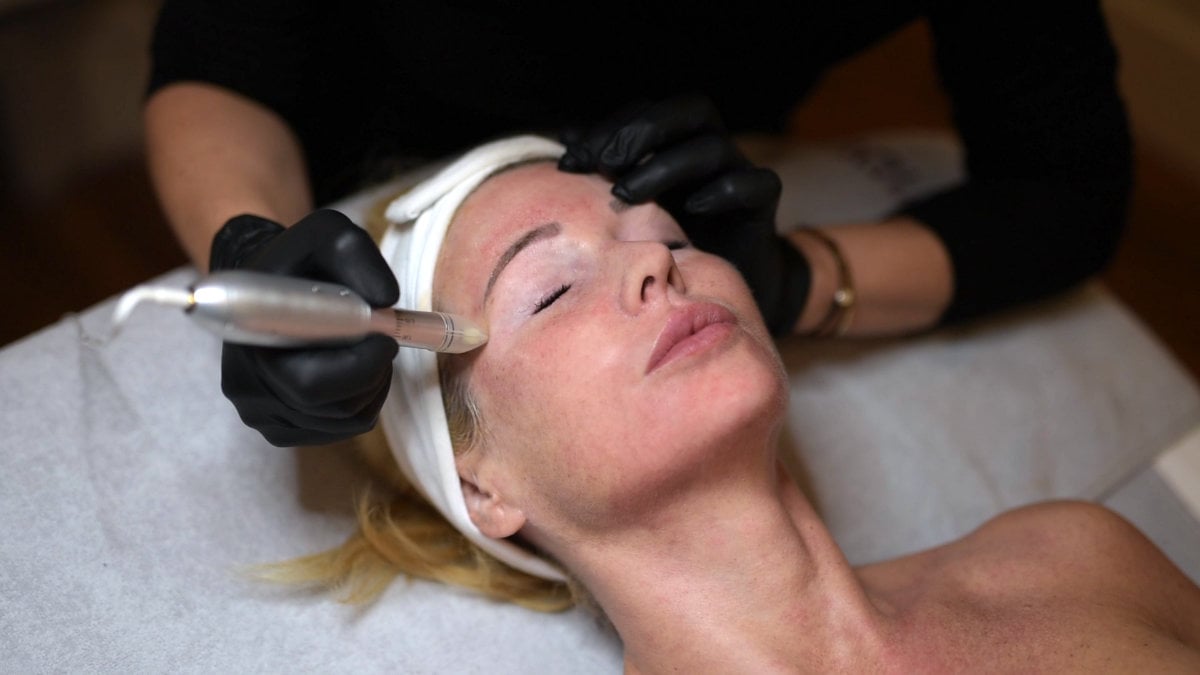My Personal Experience
Does the Famous Vampire Lift Really Work?
In this article, I shall describe in detail my first experience with Vampire Lifting. Vampire Lifting is a new and popular facial rejuvenation treatment. Thanks to Kim Kardashian and numerous other celebrities, the “Vampire Facial”, as it is also called in America, became famous on Instagram. I have been planning to treat my patients with it for a while. But first I wanted to gather my experience with it. I wanted to see how a Vampire Lift feels and what it does to the skin. And how long it takes afterwards until you are “presentable” again. Of course, I was particularly interested in that. Because on the “before and after” photos that circulate on the web, you see red, bloody faces – and none of my patients want to be seen in public like that.
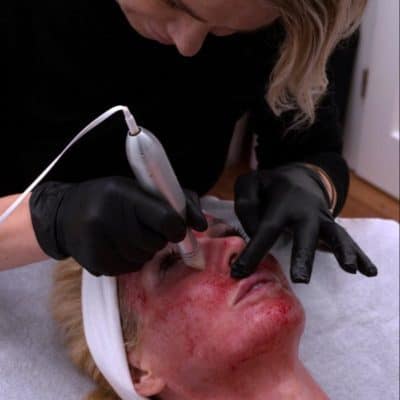
My First Vampire Lift
A few weeks ago, the time had finally come: I performed a vampire lift on my face. Beautician Ewa Jürgens helped me with the needling, which I could hardly do on my own. All the rest, like taking the blood and extracting the PRP (Platelet Rich Plasma) I did myself. In this article, I will describe my impressions and learnings from the treatment. To keep my report clear and easy to follow, I have divided it into the following sections:
- What exactly is a Vampire Lift?
- My initial situation
- Video of the entire treatment
- Preparation for the Vampire Lift
- After the treatment
- The first few days after the treatment
- My conclusions
What Exactly is a Vampire Lift?
Platelet Rich Plasma (PRP)
“Vampire lifting” is actually a new name for an old technique. The term suggests that it is about blood. More precisely, the patient’s own blood. Vampire lifting is therefore foremost an autologous blood therapy. Treatment with the patient’s own blood has been well known in medicine for a long time; it is also referred to as “autologous” blood therapy. The Greek word autologous (literally: belonging to) emphasizes that we are talking about the patient’s blood. And not a preparation obtained from donor blood. The fact that only the patient’s own blood and no additional ingredients such as cosmeceuticals are used in a vampire lift also makes it interesting from various points of view, like low risk of intolerance or cost.
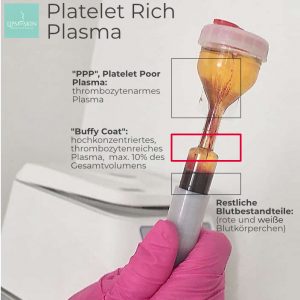
However, a vampire lift is not about the blood as a whole. Rather, it is only the blood plasma that is of interest. And even more precisely: the platelets contained in the plasma, the so-called “thrombocytes”. A central aspect of a vampire lift is to extract the plasma with the platelets from the patient’s blood, and then to concentrate it. This is done in a blood centrifuge.
The result is “platelet-rich” plasma. There is an abbreviation for this that is already very well known in cosmetics: “PRP”. PRP is short for platelet-rich plasma. Occasionally, the treatment is also called “plasma therapy” or “plasma lifting”. But I find this rather confusing because these terms are already used for other procedures that have nothing to do with blood plasma or vampire lifting.
Vampire Lift = PRP + Microneedling
PRP is a stand-alone therapy. It originated in orthopaedics and has quickly spread to aesthetic medicine. With PRP, platelet-rich plasma is extracted from the blood, concentrated and then re-injected. Into the face, above all. But also into the scalp to stimulate hair growth. However, PRP injections into the face are not yet a vampire lift, even if it is sometimes presented that way. For a real vampire lift, PRP has to be combined with another treatment: medical microneedling.
In a microneedling, the skin is perforated many times with fine needles using different devices (rollers, needling pens) to stimulate the production of new collagen fibres in the deep layers of the skin. In the process, microfine channels are pricked into the skin, as a by-product so to speak. And these channels are open for about 30 min. This is long enough to transport active ingredients from the surface into the deep layers of the skin (dermis). And that is precisely what we want to achieve in a vampire lift: to bring the PRP deep into the dermis, where it can unfold its effect.
No Wounds and No Scars After a Vampire Lift
For those who think of wounds and scars when they think of needles in the face, I can reassure you: Vampire lifting does neither cause open wounds nor scars. Because the skin is only injured in depth, not on the surface. The uppermost skin cells, the “epidermis”, remain intact during the treatment and are literally only “pushed aside” by the needles. Negative vampire lift experiences that are reported on web and social media therefore seem mostly incomprehensible to me. On the contrary, the fact that a vampire lift does not damage the skin surface is one of the great advantages relative to other rejuvenation treatments such as ablative laser or chemical peel. However, this is of course only true if an experienced doctor performs the needling. As with many other facial treatments, negative experiences with vampire lifts are almost always associated with the work of non-professionals.
A Vampire Lift has a double effect
The combination of microneedling and PRP is what makes a vampire lift so effective. Both treatments employ the body’s self-healing powers. Needling activates them by causing micro-injuries deep in the skin. Already on its own, this stimulates the synthesis of collagen and the formation of new tissue. PRP, in addition, provides all the necessary cellular factors necessary for the process in highly concentrated form.
Microneedling is one of the most effective skin rejuvenation treatments in its own right. But with a vampire lift, it gets a kind of “turbo”. This is because the PRP makes growth factors available to the new tissue formation in 2-3x higher concentrations than normal. In my experience, this makes vampire lifting the perfect facial rejuvenation treatment. Especially since the absence of expensive third-party additives such as cosmeceuticals keeps the price of the treatment within acceptable limits, thus allowing the treatment being repeated several times in short intervals. And frequent repetition will compound its effect.
Only Deep Needling is Good Needling
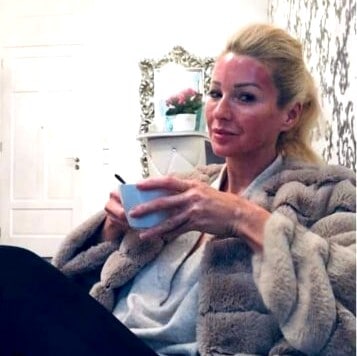
When it comes to needling, one aspect is important: It must go deep. Otherwise, the collagen synthesis will not be kicked off. The 0.3-0.5 mm depths typically offered by cosmetic studios are not deep enough. And you can also forget about all kinds of do-it-yourself using a needling roller from the drug store. None of this will bring you the benefits of a real deep microneedling.
The needling must reach into the dermis to trigger bleeding in the deep layers of the skin. Only then does the wound healing process get activated. And with it, synthesis of new collagen, elastin and hyaluronic acid.
This is essential for a real vampire lift. But this requires needling depths of at least 0.75 mm, better still 1-2 mm. However, only doctors are allowed to work at such depths (at least in Germany), where the needles penetrate far into the dermis. Hence, the name medical needling.
Vampire Lift Only by the Expert!
At this point, a word of warning: Microneedling is simple, but not easy. Needling at greater depth, going beyond the so-called basal membrane and injuring the dermis, can have nasty consequences if done improperly. Scars and pigmentation disorders, for example. So, in your interest, beware of cheap offers from unqualified actors. The negative consequences of a botched vampire lift are not worth the discount in price. When you study reports on the web and on social media about negative vampire lift experiences, they almost always involve unqualified providers or failed do-it-yourself treatments.
Therefore, even if I may start sounding like a broken record: Medical needling and vampire lift only by professionals! In Germany, this means the treatment has to be under the supervision of a medical practitioner.
Does a Vampire-Lift have to be bloody?
A vampire lift does not work without bleeding in the treated areas. The so-called petechial haemorrhages from the upper layers of the dermis are an unmistakable sign that the needling goes deep enough to trigger the wound healing process. It seems very likely to me that vampire lift owes its name more to this fact than to the autologous blood plasma used in the process. Because the first time the term was coined in public media, it was illustrated with the blood-red smeared face of Kim Kardashian. The PRP that is administered during the vampire lift, on the other hand, is more of a yellowish colour.
How Long Does the Effect of a Vampire Lift Last?
Ideally, a vampire lift should be done 3–5 times every 4 weeks at the beginning and then be repeated 1–2 times a year. You can also increase the frequency for higher impact. I, for example, do a vampire lift every 3–4 months. Medical needling and vampire lift have become the number 1 facial treatments for me personally. And believe me: I also do Botox and fillers regularly. But none of these treatments can accomplish what a vampire lift can: truly rejuvenate the skin. And the more often you repeat the treatment, the more visible the rejuvenated skin becomes. However, if you prefer to do less frequent, the effect will still last 6–12 months.
My Initial Situation
Vampire Lift Before and After
What is my motivation to describe my experiences with vampire lift here? It’s simple: On the one hand, as a professional in aesthetic medicine, you often learn about new treatments that sound good on paper and in workshop demonstrations. But you rarely know whether they actually bring about the desired success. And how they feel for patients. Both are important to me. There is no procedure in my treatment programme that I have not had done on myself before I started treating my patients with it. Of course, there are many “before and after” photos of vampire lifts on the web and dozens of videos that you can watch on YouTube. But personal experience is always the best.
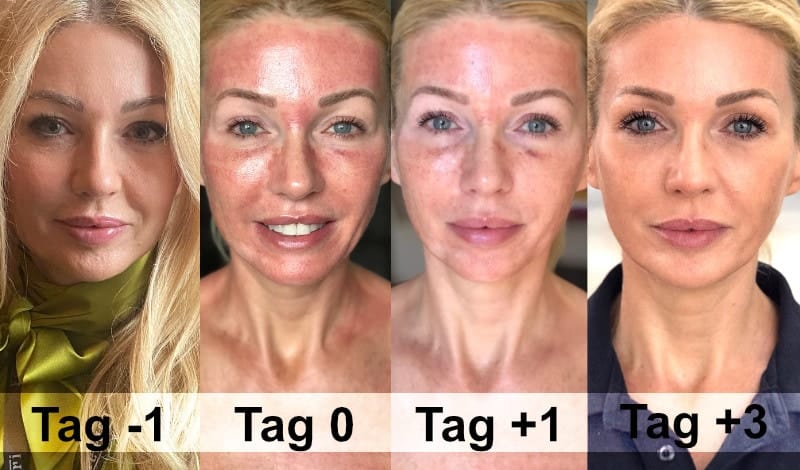
As you can see from this sequence of pictures, the redness is very severe at first. This is an essential take-away from my first treatment: there may be no “downtime” in the strict sense, but it’s up for debate whether one wants to appear in public like this. I don’t. That’s why I advise my patients to make room in their agendas when they plan a vampire lift. At list during the following 2–3 days they should not plan important appointments.
Poor Complexion and Dark Circles Under the Eyes
From a cosmetic standpoint, this is how I would summarize my initial situation:
- First, as a woman over 50, there is always something to improve about my skin. One of my treatment goals, therefore, that I wanted to significantly reduce the appearance of small lines and wrinkles to achieve an even complexion.
- Second, I had also read that a vampire lift would be excellent against a tired facial expression, and especially against dark circles under the eyes. To conjure up a fresh, vital look on the face: if the vampire lift could accomplish that, then that would certainly be very welcome.
My Vampire Lift on Video
But enough now of the long preface. Here is the video of my treatment. You can see the complete procedure from A to Z. I will comment on the individual steps in detail under the clip. My apologies to non-German-speakers for not having sub-titled the clip yet with English translations – I will do so in later revisions of this blog article.
You are currently viewing a placeholder content from YouTube. To access the actual content, click the button below. Please note that doing so will share data with third-party providers.
Preparation for the Vampire Lift
Microdermabrasion
In preparation for the vampire lift, my cosmetician Ewa recommended a thorough microdermabrasion at least 2–3 days before the treatment. Horny and dead skin layers would thus be removed, making the skin more receptive and thus creating optimal conditions for the subsequent vampire lifting. Alternatively, a fruit acid peeling would also have served this purpose. However, I, personally, don’t like chemical peels on my skin, so I preferred microdermabrasion. I did one exactly one week before the vampire lift. (By the way, this step is optional and not necessary for a successful vampire lift.)
Topical Anaesthesia
My strong advice: Under no circumstances should you forgo a local anaesthetic (i.e. with numbing cream). If you want your treatment to be remembered positively, then you should take it to heart. In the video, you may have noticed that my neck and décolleté are covered with a plastic foil. This technique called “occlusion” enhances the effect of the numbing cream. And surely, I was happy about that. If anyone tells you they’ve had a vampire lift done without anaesthetic, and it wasn’t painful, they’re lying. Or it wasn’t a real vampire lift, i.e. the needling was shallow at best. I am not particularly sensitive to pain myself, but I would not endure a deep needling without anaesthetic. Therefore, I say it clear: A vampire lift without topical anaesthesia cannot possibly be real – save yourself the cost!
Kim Kardashians Regret
One very prominent lady who apparently feels the same way as me is Kim Kardashian. She of all people, who helped the vampire facial gain worldwide fame, now regrets the treatment, according to this article. Why? Because of her pregnancy, she did it without the anaesthetic (lidocaine, which is contraindicated in pregnancy)! The pain must have been extremely intense. And so, she now calls it “the only cosmetic treatment I would never do again.” And I agree with her: with anaesthesia, it is one of my favourite facial treatments. But without anaesthesia, I would not do it even once more.
Enzymatic Peel
In the video, Ewa first applies a white paste to my face. This is an enzymatic peel. It is used to cleanse the skin down to the pores. After a short exposure time, the peel is wiped off and the skin is cleaned and degreased with alcohol. This step is optional for a vampire lift and if you want to save costs, you can also do without it.
PRP Application and Needling
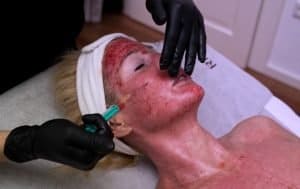
During the next step, you can see how my blood plasma is poured onto my skin and then needled in. The longer the needling lasts, the more blood appears on my face. However, this looks more spectacular than it really is. The blood only stems from micro haemorrhages (petechial haemorrhages) from the upper layer of the dermis. These injuries are as harmless as they are typical for the treatment. After all, it is precisely these micro-injuries that are supposed to stimulate the skin to regenerate.
After the Treatment
Detox-Mask to Sooth the Skin
At the end of the treatment, Ewa applies a detox mask to my skin. She does this with her fingers because the freshly treated skin could react sensitively even to a brush, and to prevent contamination from the brush. The mask consists of a combination of micro-silver and skin-identical lipids. The mask alleviates burning and itching from the treatment. However, I hardly noticed the effect because my face was still insensitive from the numbing.
Finally, the treatment is completed with a gentle cleansing of the face.
Vampir Lifting After Care
For after-care, Ewa gave me a set of care products to take home. It included a highly hydrating skin cream and a UV protection with SPF 30. Of course, you can use the care products of your choice instead. In my experience, the SPF cannot be high enough in the first few days after a vampire lift. Use at least SPF 30, better still SPF 50. And in any case, avoid direct sunlight.
The First 3 Days After the Treatment
Day 1:
Major take-away from looking into the mirror: You can NOT be seen in public like this! My face was red like a tomato. No woman I know wants to go to a restaurant or the opera, or even only be seen at the workplace like this. While a vampire lift certainly entails no downtime in the strict sense, I think it is fair to say that it prevents you from participating in social life for at least a day or two. In particular, as you would rather not want to plaster your freshly needled skin with a thick layer of make-up.
Day 2: Better, but …
On day 2, the redness was better but still clearly visible. I still looked as if I had a severe sunburn in the face. Nevertheless, in the evening of that day I went out, with my usual make-up. The redness and traces from the treatment were well covered and barely visible.
Day 3: A Soft Glow sets in

On the 3rd day after the treatment, the redness had almost disappeared. The skin looked very smooth and fresh. Only a small haematoma was still visible under the right eyelid. In my opinion, the beautiful soft glow on the face was clearly visible. The skin now simply looked fresher and more vital, even if a few minor traces of the treatment were still visible.
My Conclusions
So, what are my conclusions? I believe that the treatment is as thorough as it is effective, and can be endured frequently, provided proper topical anaesthesia. My vampire lift had no serious side effects, except for the traces of treatment still being clearly visible 2 days after treatment. You are back on your feet immediately after the treatment, there is no downtime in a clinical sense, but still, you will probably have to interrupt your social life for at least 48 hours, until redness and other traces of treatment receded.
What is the Cost of a Treatment as Shown Here?
Following this report, I was asked by readers how much a vampire lift would cost if it were carried out as described here. I would quote 500–600 euros as indicative price. If you assume 3 to 5 initial treatments at intervals of 4 weeks, then admittedly this will add up to a considerable amount, spread over a time-span of 5–6 months. With follow-up treatments necessary only every 6–12 months, however, this is put into perspective. (All prices mentioned are indicative only, the actual billing is done according to the German Medical Fee Schedule (GOÄ)).
Post-Script After 7 Months
My experience report, including all photos and videos, dates from the beginning of November 2018. 7 months have passed meanwhile, during which I have repeated the treatment a total of five times at intervals of approx. 4–6 weeks. I summarize my impressions as follows:
- My skin has improved a lot. It looks smoother overall, the large pores on the nose and in the “T-zone” are much finer. Lines and small wrinkles are also less noticeable. The complexion looks fresher overall:
- The Vampire Lift has not only improved my dark under-eye circles, but made them disappear completely. Even if I’m tired now, and it shows on my face – the dark circles are no longer noticeable as they were before.
- I was not once confronted with side effects of more serious nature. The redness was sometimes stronger and sometimes weaker, always depending on the depth of the needling. A vampire lift, is accompanied by such reddening, which should not be immediately chalked up as a negative experience. You simply have to accept that. And by the way: Among the needling treatments I did was one of the “radio frequency (RF)” type. It made no difference on the reddening of the skin.
This finally brings me to the end of my report. I hope you enjoyed reading it and gained some useful information. If you need complementary info to decide whether this treatment would be right for you, please feel free to email me or book a consultation in my practice.
